PGBM70 - Organisational Performance: Tesco Case Study Report
VerifiedAdded on 2022/11/13
|21
|4793
|274
Report
AI Summary
This report undertakes a detailed investigation into the organisational performance of Tesco, a leading international retail company. It examines the significance of effective management in achieving strategic goals within a competitive business environment. The report analyzes Tesco's organisational structure, decision-making processes, and the impact of strategic, tactical, and operational measures on its overall performance. It identifies potential areas for improvement, focusing on factors that influence the organization's work processes, including strategic planning, management styles, and the role of technology. The analysis employs various performance measurement methods, including traditional and non-traditional approaches, to assess Tesco's strengths and weaknesses, providing insights into how the company can enhance its competitive advantage, improve customer satisfaction, and adapt to the dynamic global market. The report also covers the importance of data analytics in improving business processes.
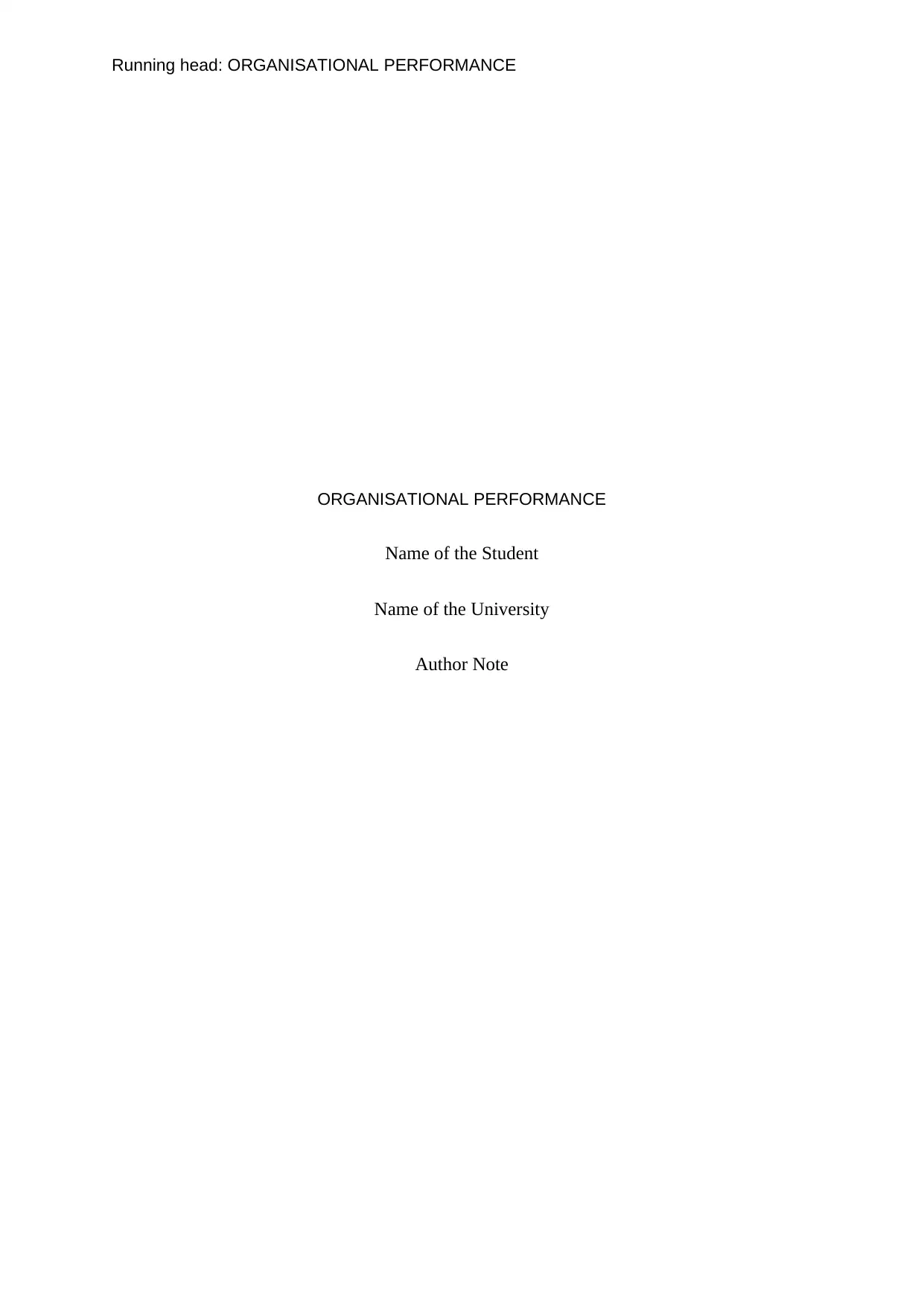
Running head: ORGANISATIONAL PERFORMANCE
ORGANISATIONAL PERFORMANCE
Name of the Student
Name of the University
Author Note
ORGANISATIONAL PERFORMANCE
Name of the Student
Name of the University
Author Note
Paraphrase This Document
Need a fresh take? Get an instant paraphrase of this document with our AI Paraphraser
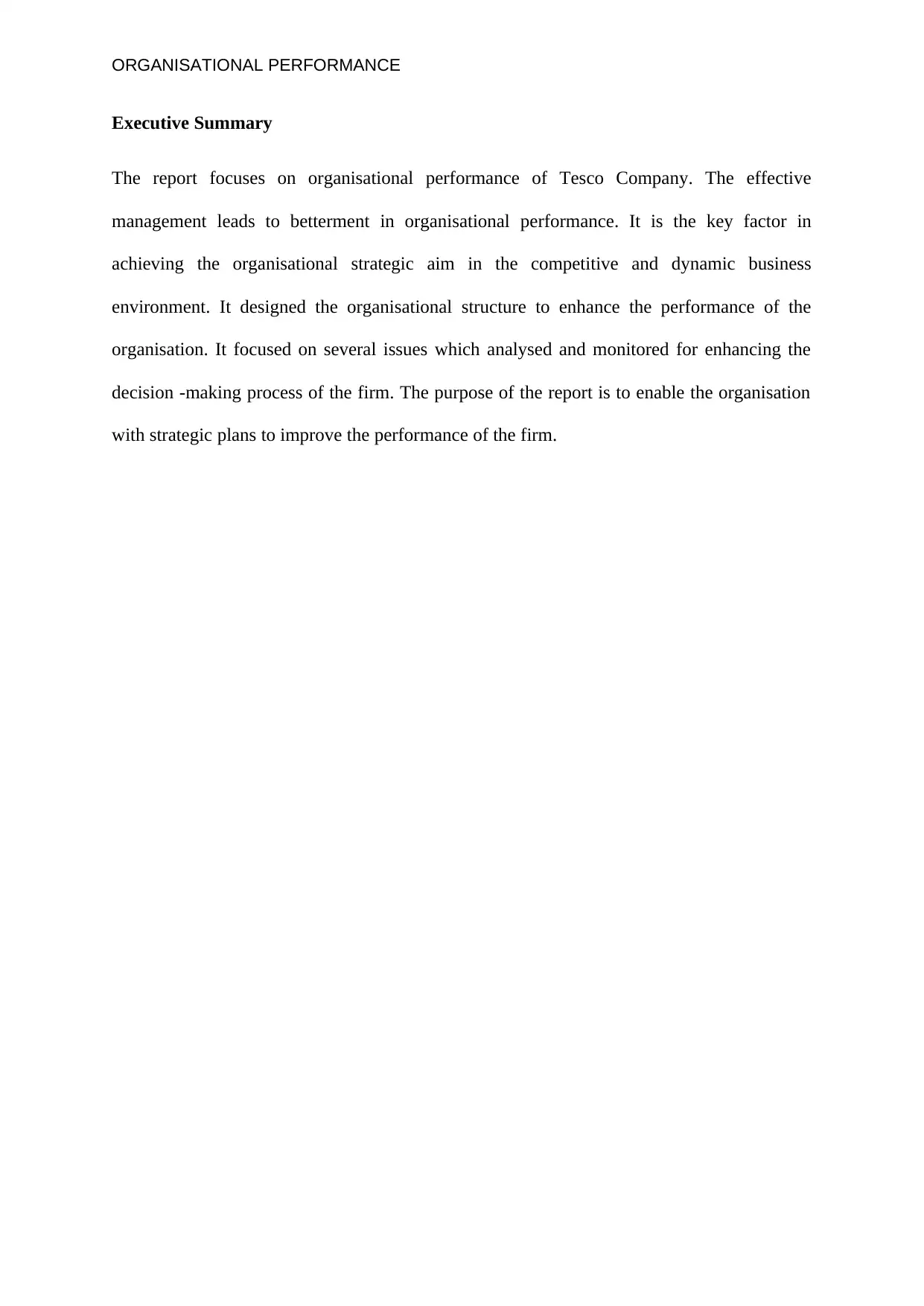
ORGANISATIONAL PERFORMANCE
Executive Summary
The report focuses on organisational performance of Tesco Company. The effective
management leads to betterment in organisational performance. It is the key factor in
achieving the organisational strategic aim in the competitive and dynamic business
environment. It designed the organisational structure to enhance the performance of the
organisation. It focused on several issues which analysed and monitored for enhancing the
decision -making process of the firm. The purpose of the report is to enable the organisation
with strategic plans to improve the performance of the firm.
Executive Summary
The report focuses on organisational performance of Tesco Company. The effective
management leads to betterment in organisational performance. It is the key factor in
achieving the organisational strategic aim in the competitive and dynamic business
environment. It designed the organisational structure to enhance the performance of the
organisation. It focused on several issues which analysed and monitored for enhancing the
decision -making process of the firm. The purpose of the report is to enable the organisation
with strategic plans to improve the performance of the firm.
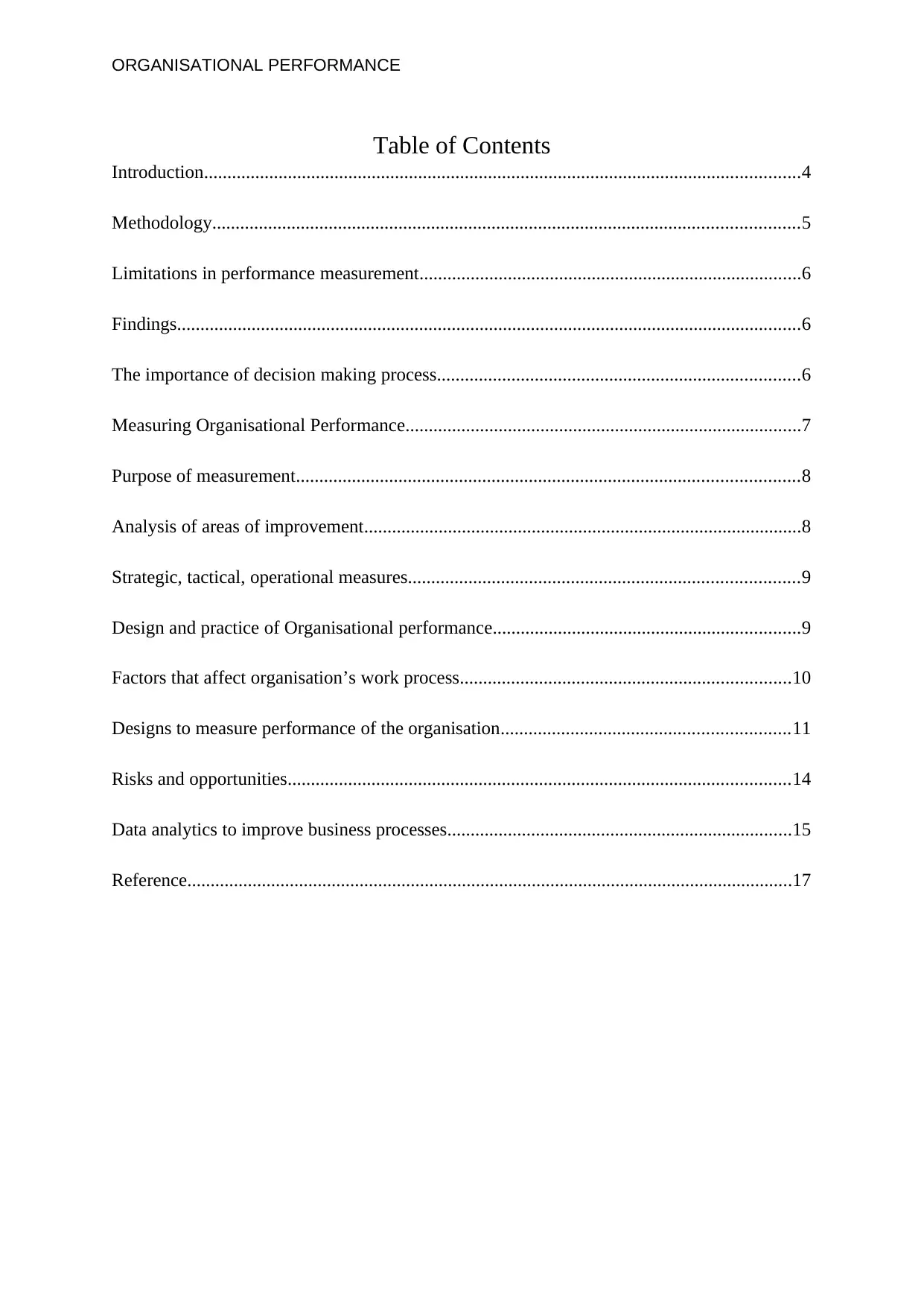
ORGANISATIONAL PERFORMANCE
Table of Contents
Introduction................................................................................................................................4
Methodology..............................................................................................................................5
Limitations in performance measurement..................................................................................6
Findings......................................................................................................................................6
The importance of decision making process..............................................................................6
Measuring Organisational Performance.....................................................................................7
Purpose of measurement............................................................................................................8
Analysis of areas of improvement..............................................................................................8
Strategic, tactical, operational measures....................................................................................9
Design and practice of Organisational performance..................................................................9
Factors that affect organisation’s work process.......................................................................10
Designs to measure performance of the organisation..............................................................11
Risks and opportunities............................................................................................................14
Data analytics to improve business processes..........................................................................15
Reference..................................................................................................................................17
Table of Contents
Introduction................................................................................................................................4
Methodology..............................................................................................................................5
Limitations in performance measurement..................................................................................6
Findings......................................................................................................................................6
The importance of decision making process..............................................................................6
Measuring Organisational Performance.....................................................................................7
Purpose of measurement............................................................................................................8
Analysis of areas of improvement..............................................................................................8
Strategic, tactical, operational measures....................................................................................9
Design and practice of Organisational performance..................................................................9
Factors that affect organisation’s work process.......................................................................10
Designs to measure performance of the organisation..............................................................11
Risks and opportunities............................................................................................................14
Data analytics to improve business processes..........................................................................15
Reference..................................................................................................................................17
⊘ This is a preview!⊘
Do you want full access?
Subscribe today to unlock all pages.

Trusted by 1+ million students worldwide
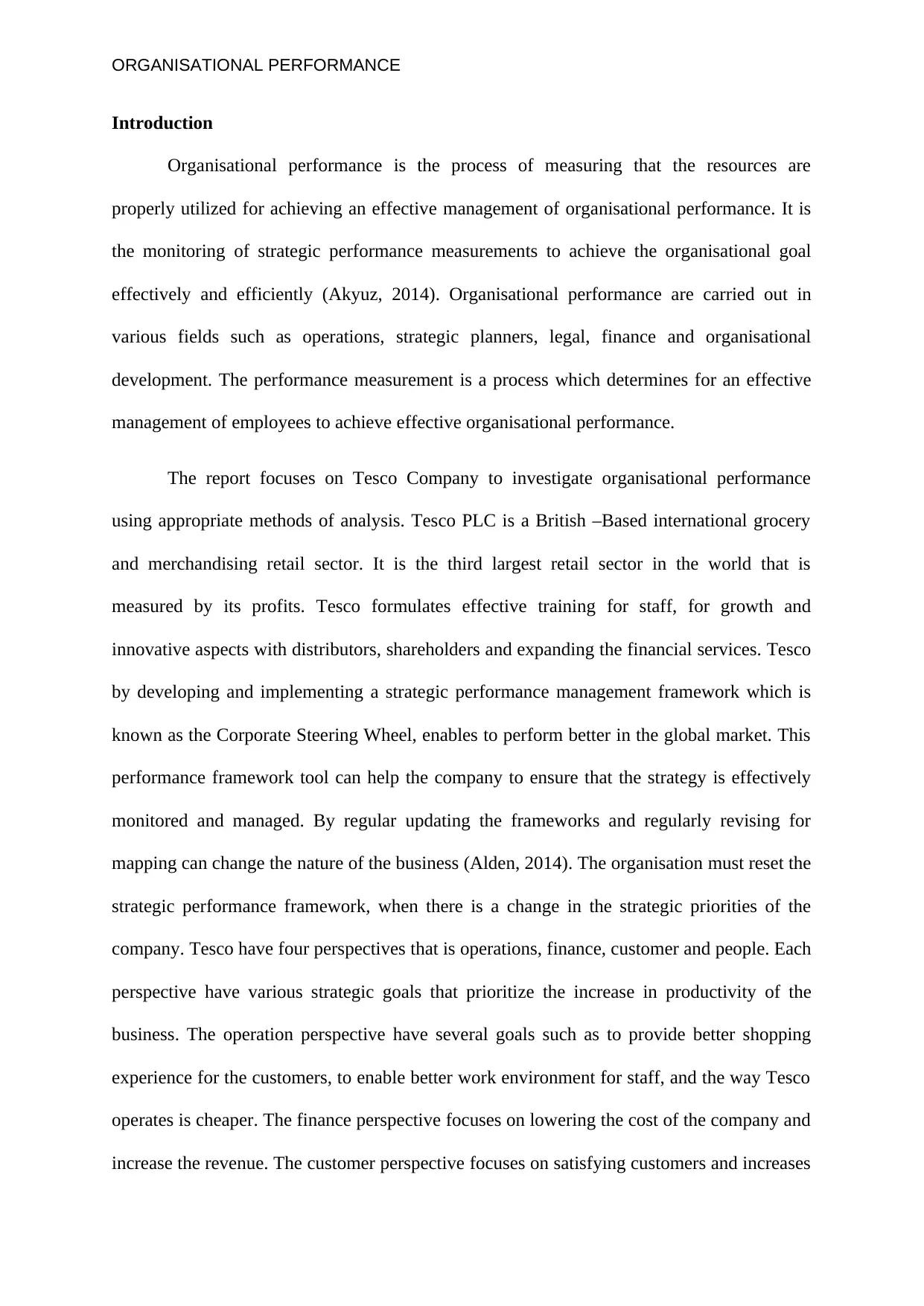
ORGANISATIONAL PERFORMANCE
Introduction
Organisational performance is the process of measuring that the resources are
properly utilized for achieving an effective management of organisational performance. It is
the monitoring of strategic performance measurements to achieve the organisational goal
effectively and efficiently (Akyuz, 2014). Organisational performance are carried out in
various fields such as operations, strategic planners, legal, finance and organisational
development. The performance measurement is a process which determines for an effective
management of employees to achieve effective organisational performance.
The report focuses on Tesco Company to investigate organisational performance
using appropriate methods of analysis. Tesco PLC is a British –Based international grocery
and merchandising retail sector. It is the third largest retail sector in the world that is
measured by its profits. Tesco formulates effective training for staff, for growth and
innovative aspects with distributors, shareholders and expanding the financial services. Tesco
by developing and implementing a strategic performance management framework which is
known as the Corporate Steering Wheel, enables to perform better in the global market. This
performance framework tool can help the company to ensure that the strategy is effectively
monitored and managed. By regular updating the frameworks and regularly revising for
mapping can change the nature of the business (Alden, 2014). The organisation must reset the
strategic performance framework, when there is a change in the strategic priorities of the
company. Tesco have four perspectives that is operations, finance, customer and people. Each
perspective have various strategic goals that prioritize the increase in productivity of the
business. The operation perspective have several goals such as to provide better shopping
experience for the customers, to enable better work environment for staff, and the way Tesco
operates is cheaper. The finance perspective focuses on lowering the cost of the company and
increase the revenue. The customer perspective focuses on satisfying customers and increases
Introduction
Organisational performance is the process of measuring that the resources are
properly utilized for achieving an effective management of organisational performance. It is
the monitoring of strategic performance measurements to achieve the organisational goal
effectively and efficiently (Akyuz, 2014). Organisational performance are carried out in
various fields such as operations, strategic planners, legal, finance and organisational
development. The performance measurement is a process which determines for an effective
management of employees to achieve effective organisational performance.
The report focuses on Tesco Company to investigate organisational performance
using appropriate methods of analysis. Tesco PLC is a British –Based international grocery
and merchandising retail sector. It is the third largest retail sector in the world that is
measured by its profits. Tesco formulates effective training for staff, for growth and
innovative aspects with distributors, shareholders and expanding the financial services. Tesco
by developing and implementing a strategic performance management framework which is
known as the Corporate Steering Wheel, enables to perform better in the global market. This
performance framework tool can help the company to ensure that the strategy is effectively
monitored and managed. By regular updating the frameworks and regularly revising for
mapping can change the nature of the business (Alden, 2014). The organisation must reset the
strategic performance framework, when there is a change in the strategic priorities of the
company. Tesco have four perspectives that is operations, finance, customer and people. Each
perspective have various strategic goals that prioritize the increase in productivity of the
business. The operation perspective have several goals such as to provide better shopping
experience for the customers, to enable better work environment for staff, and the way Tesco
operates is cheaper. The finance perspective focuses on lowering the cost of the company and
increase the revenue. The customer perspective focuses on satisfying customers and increases
Paraphrase This Document
Need a fresh take? Get an instant paraphrase of this document with our AI Paraphraser
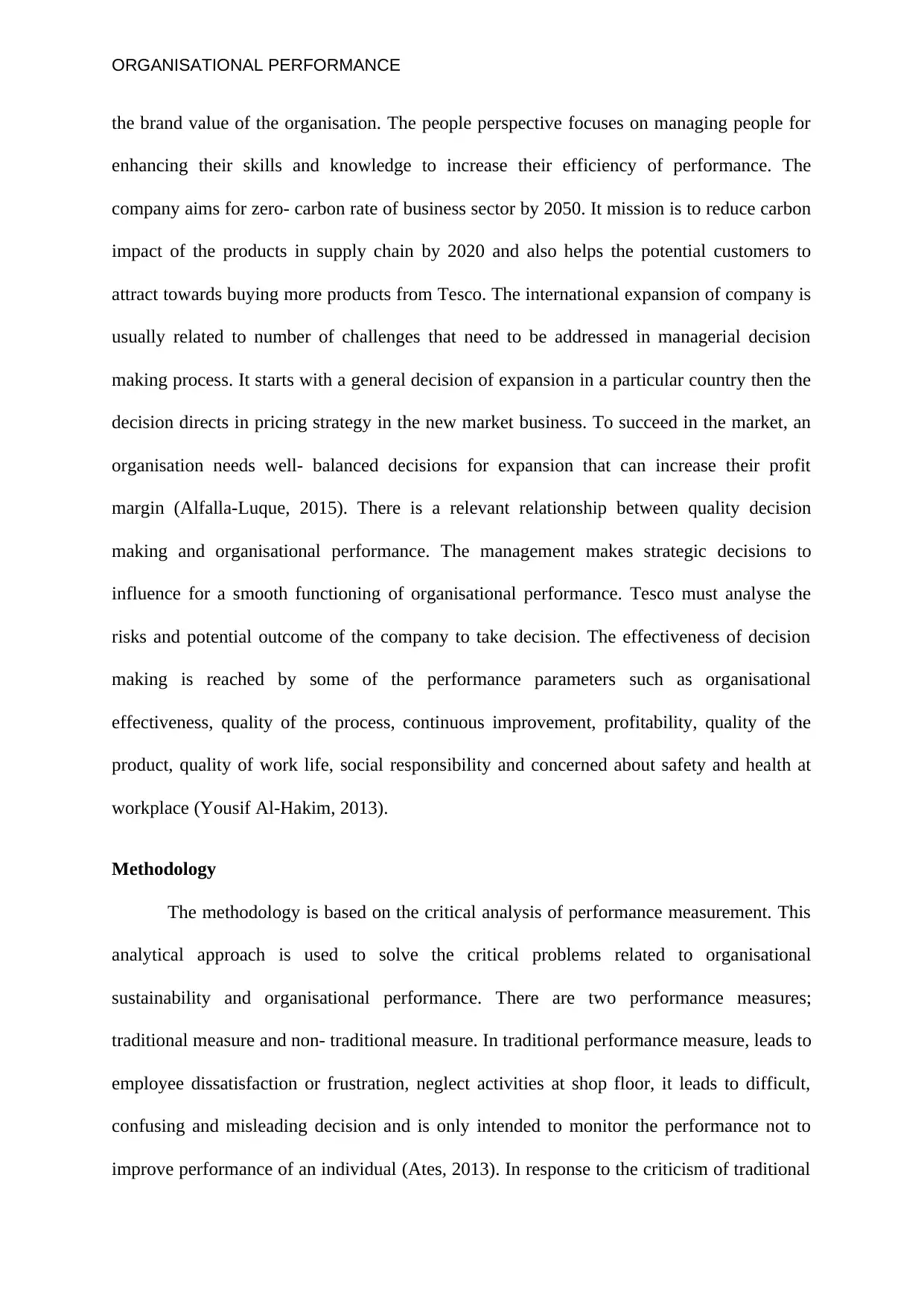
ORGANISATIONAL PERFORMANCE
the brand value of the organisation. The people perspective focuses on managing people for
enhancing their skills and knowledge to increase their efficiency of performance. The
company aims for zero- carbon rate of business sector by 2050. It mission is to reduce carbon
impact of the products in supply chain by 2020 and also helps the potential customers to
attract towards buying more products from Tesco. The international expansion of company is
usually related to number of challenges that need to be addressed in managerial decision
making process. It starts with a general decision of expansion in a particular country then the
decision directs in pricing strategy in the new market business. To succeed in the market, an
organisation needs well- balanced decisions for expansion that can increase their profit
margin (Alfalla-Luque, 2015). There is a relevant relationship between quality decision
making and organisational performance. The management makes strategic decisions to
influence for a smooth functioning of organisational performance. Tesco must analyse the
risks and potential outcome of the company to take decision. The effectiveness of decision
making is reached by some of the performance parameters such as organisational
effectiveness, quality of the process, continuous improvement, profitability, quality of the
product, quality of work life, social responsibility and concerned about safety and health at
workplace (Yousif Al-Hakim, 2013).
Methodology
The methodology is based on the critical analysis of performance measurement. This
analytical approach is used to solve the critical problems related to organisational
sustainability and organisational performance. There are two performance measures;
traditional measure and non- traditional measure. In traditional performance measure, leads to
employee dissatisfaction or frustration, neglect activities at shop floor, it leads to difficult,
confusing and misleading decision and is only intended to monitor the performance not to
improve performance of an individual (Ates, 2013). In response to the criticism of traditional
the brand value of the organisation. The people perspective focuses on managing people for
enhancing their skills and knowledge to increase their efficiency of performance. The
company aims for zero- carbon rate of business sector by 2050. It mission is to reduce carbon
impact of the products in supply chain by 2020 and also helps the potential customers to
attract towards buying more products from Tesco. The international expansion of company is
usually related to number of challenges that need to be addressed in managerial decision
making process. It starts with a general decision of expansion in a particular country then the
decision directs in pricing strategy in the new market business. To succeed in the market, an
organisation needs well- balanced decisions for expansion that can increase their profit
margin (Alfalla-Luque, 2015). There is a relevant relationship between quality decision
making and organisational performance. The management makes strategic decisions to
influence for a smooth functioning of organisational performance. Tesco must analyse the
risks and potential outcome of the company to take decision. The effectiveness of decision
making is reached by some of the performance parameters such as organisational
effectiveness, quality of the process, continuous improvement, profitability, quality of the
product, quality of work life, social responsibility and concerned about safety and health at
workplace (Yousif Al-Hakim, 2013).
Methodology
The methodology is based on the critical analysis of performance measurement. This
analytical approach is used to solve the critical problems related to organisational
sustainability and organisational performance. There are two performance measures;
traditional measure and non- traditional measure. In traditional performance measure, leads to
employee dissatisfaction or frustration, neglect activities at shop floor, it leads to difficult,
confusing and misleading decision and is only intended to monitor the performance not to
improve performance of an individual (Ates, 2013). In response to the criticism of traditional
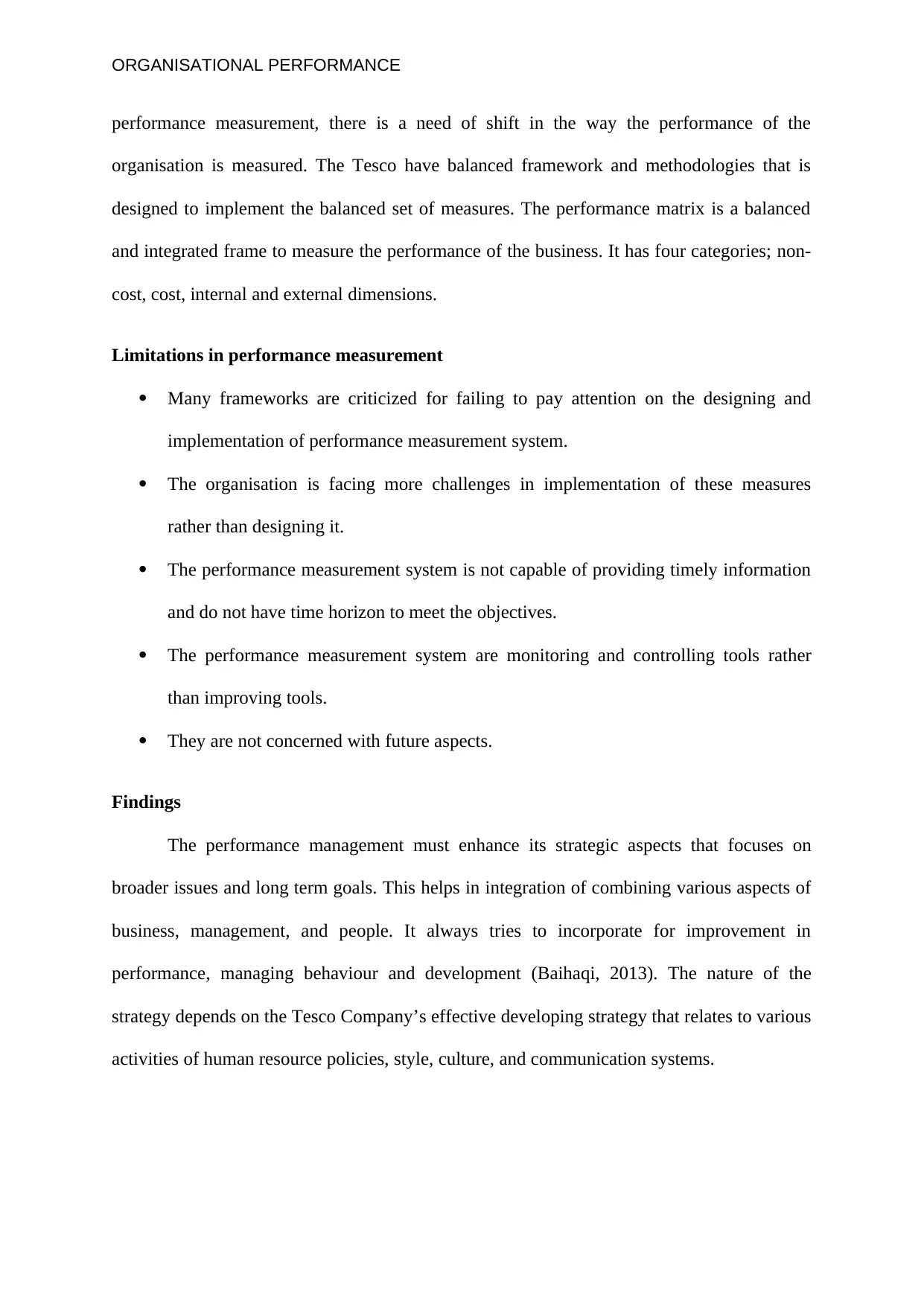
ORGANISATIONAL PERFORMANCE
performance measurement, there is a need of shift in the way the performance of the
organisation is measured. The Tesco have balanced framework and methodologies that is
designed to implement the balanced set of measures. The performance matrix is a balanced
and integrated frame to measure the performance of the business. It has four categories; non-
cost, cost, internal and external dimensions.
Limitations in performance measurement
Many frameworks are criticized for failing to pay attention on the designing and
implementation of performance measurement system.
The organisation is facing more challenges in implementation of these measures
rather than designing it.
The performance measurement system is not capable of providing timely information
and do not have time horizon to meet the objectives.
The performance measurement system are monitoring and controlling tools rather
than improving tools.
They are not concerned with future aspects.
Findings
The performance management must enhance its strategic aspects that focuses on
broader issues and long term goals. This helps in integration of combining various aspects of
business, management, and people. It always tries to incorporate for improvement in
performance, managing behaviour and development (Baihaqi, 2013). The nature of the
strategy depends on the Tesco Company’s effective developing strategy that relates to various
activities of human resource policies, style, culture, and communication systems.
performance measurement, there is a need of shift in the way the performance of the
organisation is measured. The Tesco have balanced framework and methodologies that is
designed to implement the balanced set of measures. The performance matrix is a balanced
and integrated frame to measure the performance of the business. It has four categories; non-
cost, cost, internal and external dimensions.
Limitations in performance measurement
Many frameworks are criticized for failing to pay attention on the designing and
implementation of performance measurement system.
The organisation is facing more challenges in implementation of these measures
rather than designing it.
The performance measurement system is not capable of providing timely information
and do not have time horizon to meet the objectives.
The performance measurement system are monitoring and controlling tools rather
than improving tools.
They are not concerned with future aspects.
Findings
The performance management must enhance its strategic aspects that focuses on
broader issues and long term goals. This helps in integration of combining various aspects of
business, management, and people. It always tries to incorporate for improvement in
performance, managing behaviour and development (Baihaqi, 2013). The nature of the
strategy depends on the Tesco Company’s effective developing strategy that relates to various
activities of human resource policies, style, culture, and communication systems.
⊘ This is a preview!⊘
Do you want full access?
Subscribe today to unlock all pages.

Trusted by 1+ million students worldwide
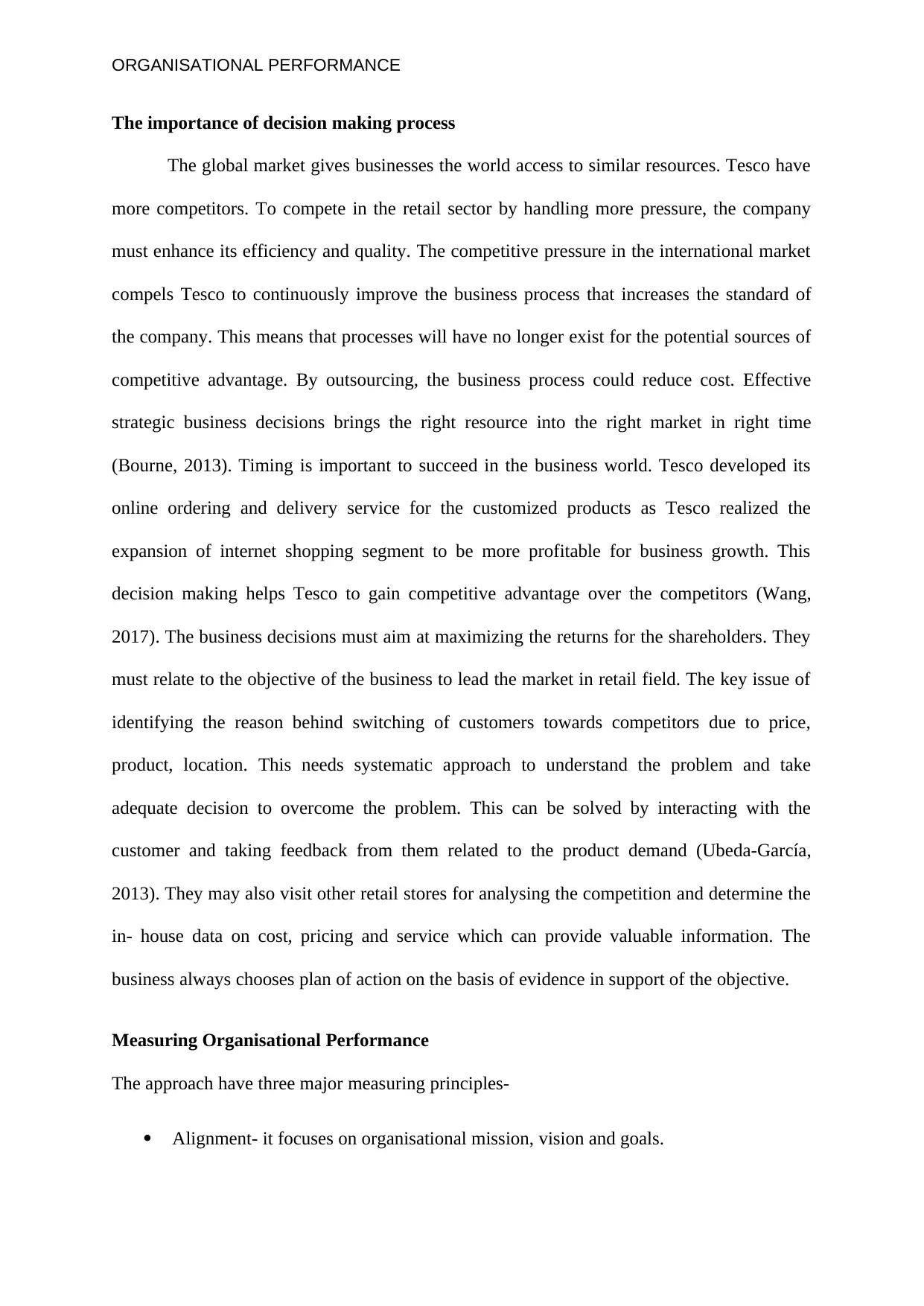
ORGANISATIONAL PERFORMANCE
The importance of decision making process
The global market gives businesses the world access to similar resources. Tesco have
more competitors. To compete in the retail sector by handling more pressure, the company
must enhance its efficiency and quality. The competitive pressure in the international market
compels Tesco to continuously improve the business process that increases the standard of
the company. This means that processes will have no longer exist for the potential sources of
competitive advantage. By outsourcing, the business process could reduce cost. Effective
strategic business decisions brings the right resource into the right market in right time
(Bourne, 2013). Timing is important to succeed in the business world. Tesco developed its
online ordering and delivery service for the customized products as Tesco realized the
expansion of internet shopping segment to be more profitable for business growth. This
decision making helps Tesco to gain competitive advantage over the competitors (Wang,
2017). The business decisions must aim at maximizing the returns for the shareholders. They
must relate to the objective of the business to lead the market in retail field. The key issue of
identifying the reason behind switching of customers towards competitors due to price,
product, location. This needs systematic approach to understand the problem and take
adequate decision to overcome the problem. This can be solved by interacting with the
customer and taking feedback from them related to the product demand (Ubeda-García,
2013). They may also visit other retail stores for analysing the competition and determine the
in- house data on cost, pricing and service which can provide valuable information. The
business always chooses plan of action on the basis of evidence in support of the objective.
Measuring Organisational Performance
The approach have three major measuring principles-
Alignment- it focuses on organisational mission, vision and goals.
The importance of decision making process
The global market gives businesses the world access to similar resources. Tesco have
more competitors. To compete in the retail sector by handling more pressure, the company
must enhance its efficiency and quality. The competitive pressure in the international market
compels Tesco to continuously improve the business process that increases the standard of
the company. This means that processes will have no longer exist for the potential sources of
competitive advantage. By outsourcing, the business process could reduce cost. Effective
strategic business decisions brings the right resource into the right market in right time
(Bourne, 2013). Timing is important to succeed in the business world. Tesco developed its
online ordering and delivery service for the customized products as Tesco realized the
expansion of internet shopping segment to be more profitable for business growth. This
decision making helps Tesco to gain competitive advantage over the competitors (Wang,
2017). The business decisions must aim at maximizing the returns for the shareholders. They
must relate to the objective of the business to lead the market in retail field. The key issue of
identifying the reason behind switching of customers towards competitors due to price,
product, location. This needs systematic approach to understand the problem and take
adequate decision to overcome the problem. This can be solved by interacting with the
customer and taking feedback from them related to the product demand (Ubeda-García,
2013). They may also visit other retail stores for analysing the competition and determine the
in- house data on cost, pricing and service which can provide valuable information. The
business always chooses plan of action on the basis of evidence in support of the objective.
Measuring Organisational Performance
The approach have three major measuring principles-
Alignment- it focuses on organisational mission, vision and goals.
Paraphrase This Document
Need a fresh take? Get an instant paraphrase of this document with our AI Paraphraser
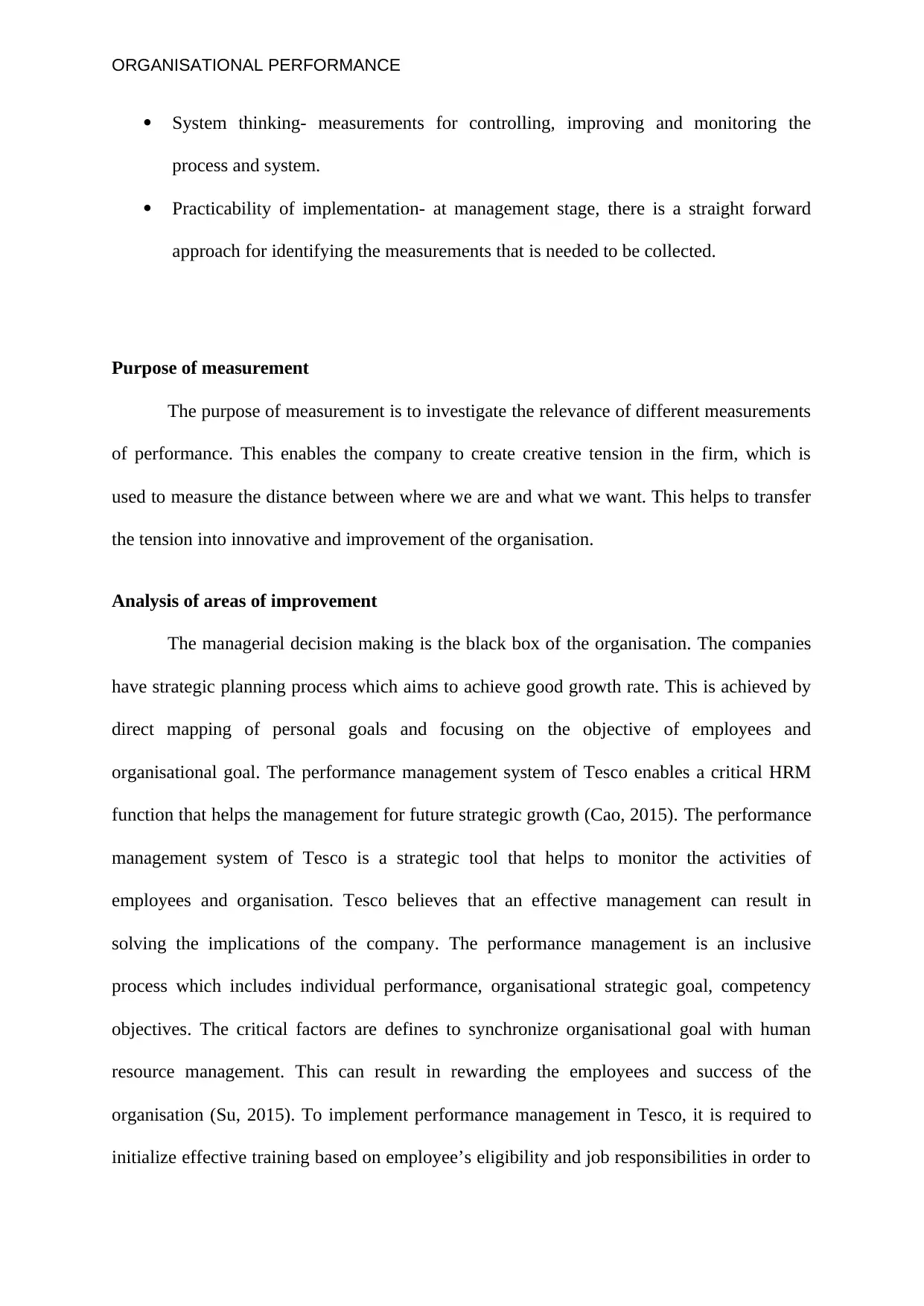
ORGANISATIONAL PERFORMANCE
System thinking- measurements for controlling, improving and monitoring the
process and system.
Practicability of implementation- at management stage, there is a straight forward
approach for identifying the measurements that is needed to be collected.
Purpose of measurement
The purpose of measurement is to investigate the relevance of different measurements
of performance. This enables the company to create creative tension in the firm, which is
used to measure the distance between where we are and what we want. This helps to transfer
the tension into innovative and improvement of the organisation.
Analysis of areas of improvement
The managerial decision making is the black box of the organisation. The companies
have strategic planning process which aims to achieve good growth rate. This is achieved by
direct mapping of personal goals and focusing on the objective of employees and
organisational goal. The performance management system of Tesco enables a critical HRM
function that helps the management for future strategic growth (Cao, 2015). The performance
management system of Tesco is a strategic tool that helps to monitor the activities of
employees and organisation. Tesco believes that an effective management can result in
solving the implications of the company. The performance management is an inclusive
process which includes individual performance, organisational strategic goal, competency
objectives. The critical factors are defines to synchronize organisational goal with human
resource management. This can result in rewarding the employees and success of the
organisation (Su, 2015). To implement performance management in Tesco, it is required to
initialize effective training based on employee’s eligibility and job responsibilities in order to
System thinking- measurements for controlling, improving and monitoring the
process and system.
Practicability of implementation- at management stage, there is a straight forward
approach for identifying the measurements that is needed to be collected.
Purpose of measurement
The purpose of measurement is to investigate the relevance of different measurements
of performance. This enables the company to create creative tension in the firm, which is
used to measure the distance between where we are and what we want. This helps to transfer
the tension into innovative and improvement of the organisation.
Analysis of areas of improvement
The managerial decision making is the black box of the organisation. The companies
have strategic planning process which aims to achieve good growth rate. This is achieved by
direct mapping of personal goals and focusing on the objective of employees and
organisational goal. The performance management system of Tesco enables a critical HRM
function that helps the management for future strategic growth (Cao, 2015). The performance
management system of Tesco is a strategic tool that helps to monitor the activities of
employees and organisation. Tesco believes that an effective management can result in
solving the implications of the company. The performance management is an inclusive
process which includes individual performance, organisational strategic goal, competency
objectives. The critical factors are defines to synchronize organisational goal with human
resource management. This can result in rewarding the employees and success of the
organisation (Su, 2015). To implement performance management in Tesco, it is required to
initialize effective training based on employee’s eligibility and job responsibilities in order to
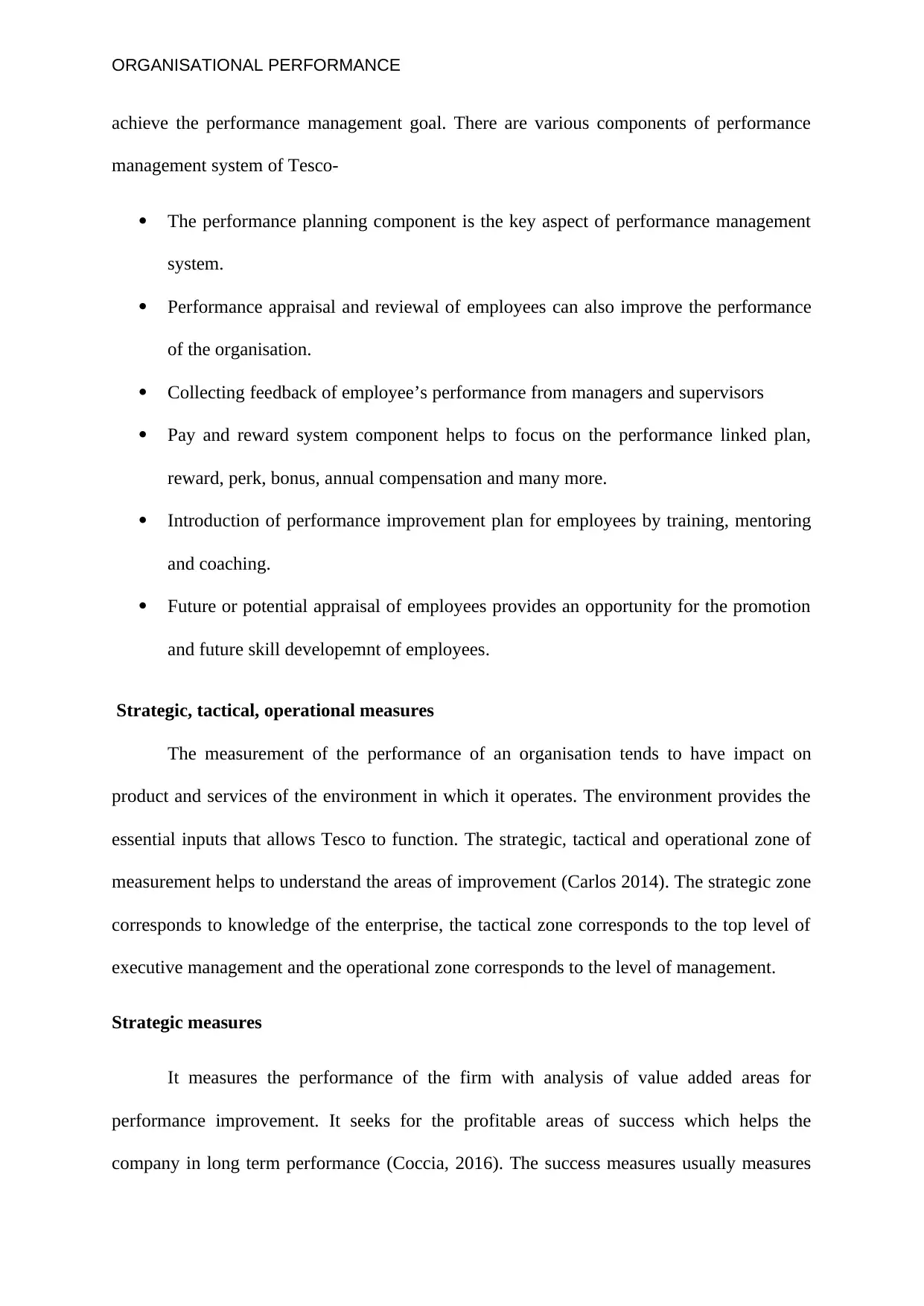
ORGANISATIONAL PERFORMANCE
achieve the performance management goal. There are various components of performance
management system of Tesco-
The performance planning component is the key aspect of performance management
system.
Performance appraisal and reviewal of employees can also improve the performance
of the organisation.
Collecting feedback of employee’s performance from managers and supervisors
Pay and reward system component helps to focus on the performance linked plan,
reward, perk, bonus, annual compensation and many more.
Introduction of performance improvement plan for employees by training, mentoring
and coaching.
Future or potential appraisal of employees provides an opportunity for the promotion
and future skill developemnt of employees.
Strategic, tactical, operational measures
The measurement of the performance of an organisation tends to have impact on
product and services of the environment in which it operates. The environment provides the
essential inputs that allows Tesco to function. The strategic, tactical and operational zone of
measurement helps to understand the areas of improvement (Carlos 2014). The strategic zone
corresponds to knowledge of the enterprise, the tactical zone corresponds to the top level of
executive management and the operational zone corresponds to the level of management.
Strategic measures
It measures the performance of the firm with analysis of value added areas for
performance improvement. It seeks for the profitable areas of success which helps the
company in long term performance (Coccia, 2016). The success measures usually measures
achieve the performance management goal. There are various components of performance
management system of Tesco-
The performance planning component is the key aspect of performance management
system.
Performance appraisal and reviewal of employees can also improve the performance
of the organisation.
Collecting feedback of employee’s performance from managers and supervisors
Pay and reward system component helps to focus on the performance linked plan,
reward, perk, bonus, annual compensation and many more.
Introduction of performance improvement plan for employees by training, mentoring
and coaching.
Future or potential appraisal of employees provides an opportunity for the promotion
and future skill developemnt of employees.
Strategic, tactical, operational measures
The measurement of the performance of an organisation tends to have impact on
product and services of the environment in which it operates. The environment provides the
essential inputs that allows Tesco to function. The strategic, tactical and operational zone of
measurement helps to understand the areas of improvement (Carlos 2014). The strategic zone
corresponds to knowledge of the enterprise, the tactical zone corresponds to the top level of
executive management and the operational zone corresponds to the level of management.
Strategic measures
It measures the performance of the firm with analysis of value added areas for
performance improvement. It seeks for the profitable areas of success which helps the
company in long term performance (Coccia, 2016). The success measures usually measures
⊘ This is a preview!⊘
Do you want full access?
Subscribe today to unlock all pages.

Trusted by 1+ million students worldwide
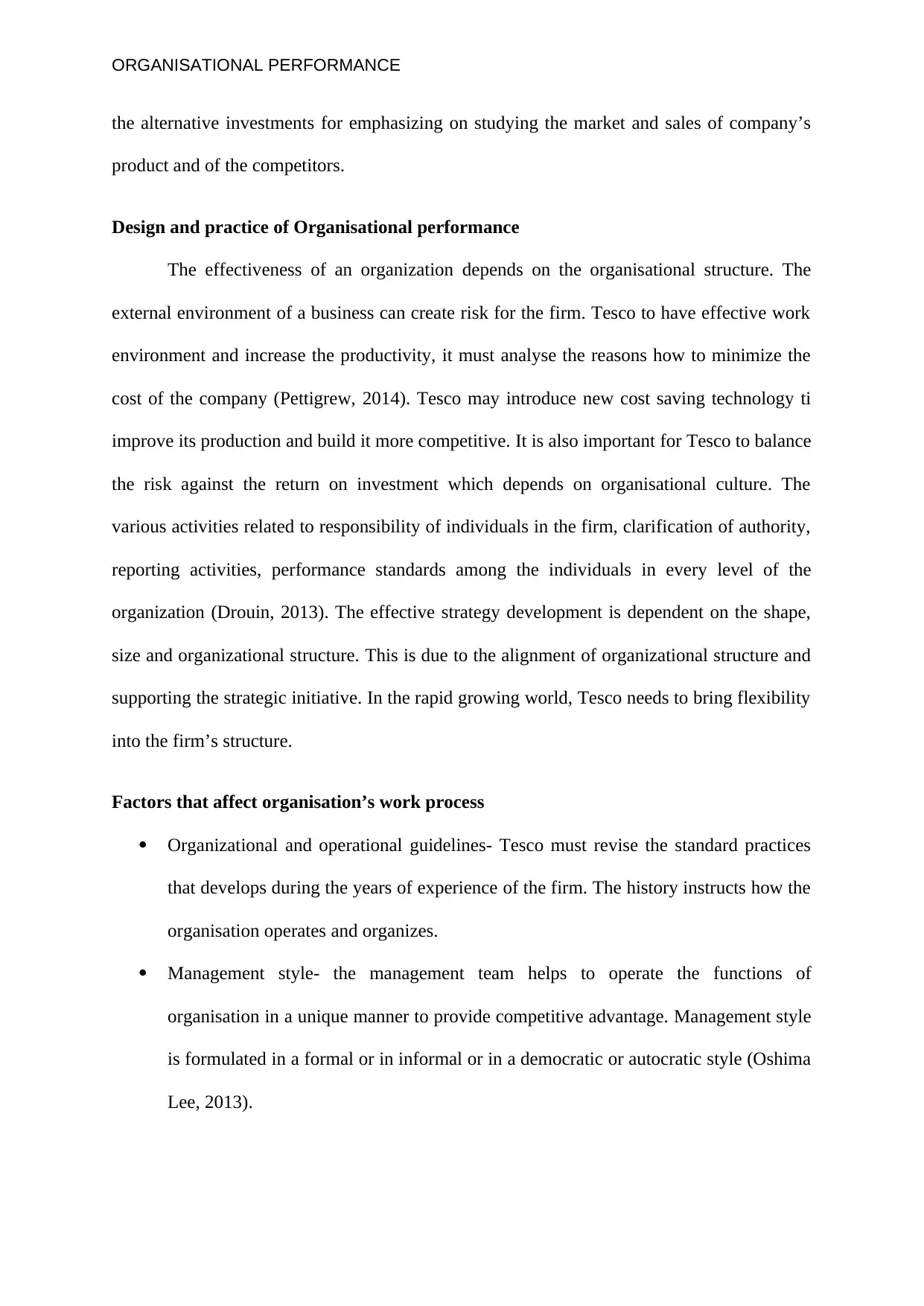
ORGANISATIONAL PERFORMANCE
the alternative investments for emphasizing on studying the market and sales of company’s
product and of the competitors.
Design and practice of Organisational performance
The effectiveness of an organization depends on the organisational structure. The
external environment of a business can create risk for the firm. Tesco to have effective work
environment and increase the productivity, it must analyse the reasons how to minimize the
cost of the company (Pettigrew, 2014). Tesco may introduce new cost saving technology ti
improve its production and build it more competitive. It is also important for Tesco to balance
the risk against the return on investment which depends on organisational culture. The
various activities related to responsibility of individuals in the firm, clarification of authority,
reporting activities, performance standards among the individuals in every level of the
organization (Drouin, 2013). The effective strategy development is dependent on the shape,
size and organizational structure. This is due to the alignment of organizational structure and
supporting the strategic initiative. In the rapid growing world, Tesco needs to bring flexibility
into the firm’s structure.
Factors that affect organisation’s work process
Organizational and operational guidelines- Tesco must revise the standard practices
that develops during the years of experience of the firm. The history instructs how the
organisation operates and organizes.
Management style- the management team helps to operate the functions of
organisation in a unique manner to provide competitive advantage. Management style
is formulated in a formal or in informal or in a democratic or autocratic style (Oshima
Lee, 2013).
the alternative investments for emphasizing on studying the market and sales of company’s
product and of the competitors.
Design and practice of Organisational performance
The effectiveness of an organization depends on the organisational structure. The
external environment of a business can create risk for the firm. Tesco to have effective work
environment and increase the productivity, it must analyse the reasons how to minimize the
cost of the company (Pettigrew, 2014). Tesco may introduce new cost saving technology ti
improve its production and build it more competitive. It is also important for Tesco to balance
the risk against the return on investment which depends on organisational culture. The
various activities related to responsibility of individuals in the firm, clarification of authority,
reporting activities, performance standards among the individuals in every level of the
organization (Drouin, 2013). The effective strategy development is dependent on the shape,
size and organizational structure. This is due to the alignment of organizational structure and
supporting the strategic initiative. In the rapid growing world, Tesco needs to bring flexibility
into the firm’s structure.
Factors that affect organisation’s work process
Organizational and operational guidelines- Tesco must revise the standard practices
that develops during the years of experience of the firm. The history instructs how the
organisation operates and organizes.
Management style- the management team helps to operate the functions of
organisation in a unique manner to provide competitive advantage. Management style
is formulated in a formal or in informal or in a democratic or autocratic style (Oshima
Lee, 2013).
Paraphrase This Document
Need a fresh take? Get an instant paraphrase of this document with our AI Paraphraser
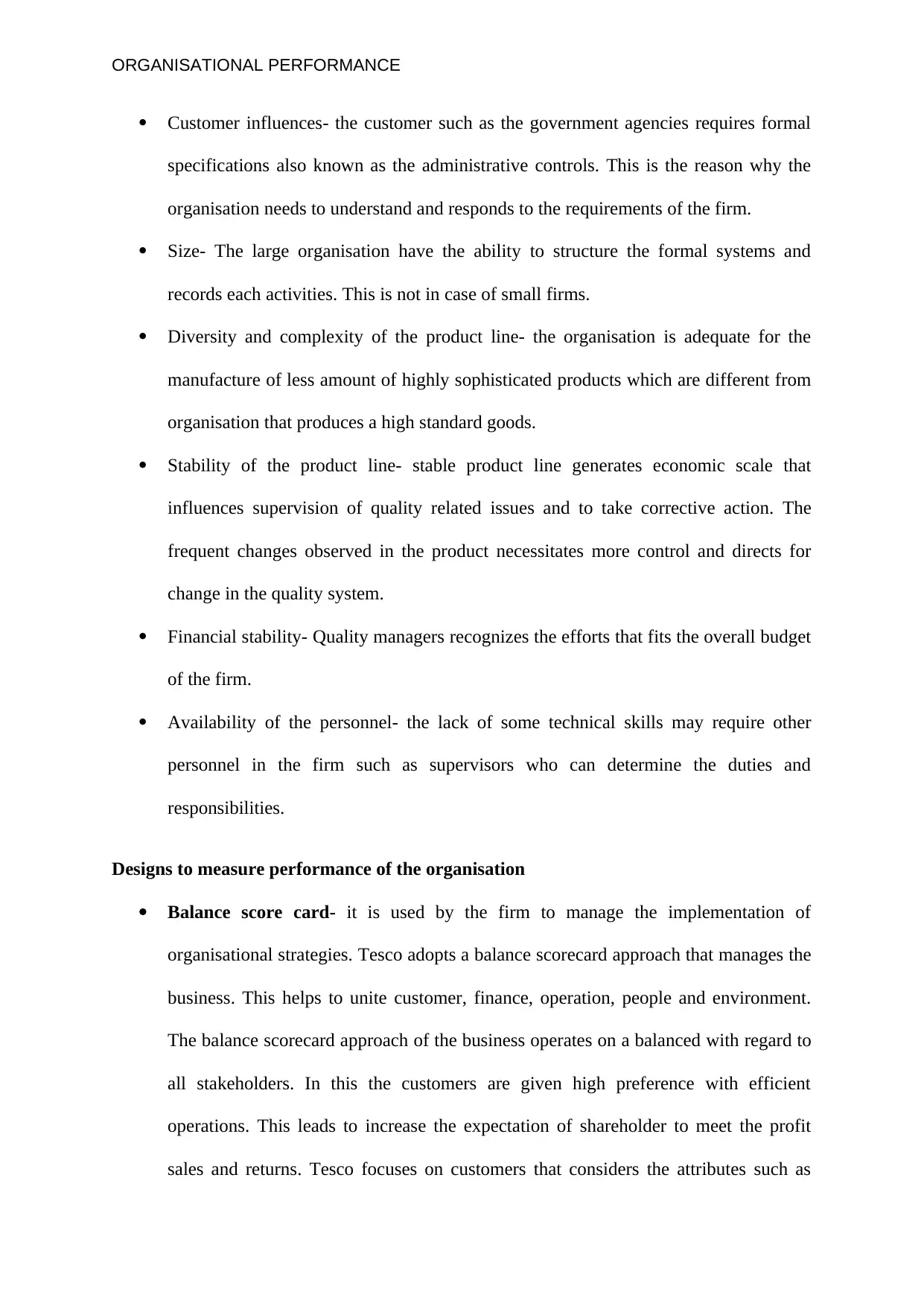
ORGANISATIONAL PERFORMANCE
Customer influences- the customer such as the government agencies requires formal
specifications also known as the administrative controls. This is the reason why the
organisation needs to understand and responds to the requirements of the firm.
Size- The large organisation have the ability to structure the formal systems and
records each activities. This is not in case of small firms.
Diversity and complexity of the product line- the organisation is adequate for the
manufacture of less amount of highly sophisticated products which are different from
organisation that produces a high standard goods.
Stability of the product line- stable product line generates economic scale that
influences supervision of quality related issues and to take corrective action. The
frequent changes observed in the product necessitates more control and directs for
change in the quality system.
Financial stability- Quality managers recognizes the efforts that fits the overall budget
of the firm.
Availability of the personnel- the lack of some technical skills may require other
personnel in the firm such as supervisors who can determine the duties and
responsibilities.
Designs to measure performance of the organisation
Balance score card- it is used by the firm to manage the implementation of
organisational strategies. Tesco adopts a balance scorecard approach that manages the
business. This helps to unite customer, finance, operation, people and environment.
The balance scorecard approach of the business operates on a balanced with regard to
all stakeholders. In this the customers are given high preference with efficient
operations. This leads to increase the expectation of shareholder to meet the profit
sales and returns. Tesco focuses on customers that considers the attributes such as
Customer influences- the customer such as the government agencies requires formal
specifications also known as the administrative controls. This is the reason why the
organisation needs to understand and responds to the requirements of the firm.
Size- The large organisation have the ability to structure the formal systems and
records each activities. This is not in case of small firms.
Diversity and complexity of the product line- the organisation is adequate for the
manufacture of less amount of highly sophisticated products which are different from
organisation that produces a high standard goods.
Stability of the product line- stable product line generates economic scale that
influences supervision of quality related issues and to take corrective action. The
frequent changes observed in the product necessitates more control and directs for
change in the quality system.
Financial stability- Quality managers recognizes the efforts that fits the overall budget
of the firm.
Availability of the personnel- the lack of some technical skills may require other
personnel in the firm such as supervisors who can determine the duties and
responsibilities.
Designs to measure performance of the organisation
Balance score card- it is used by the firm to manage the implementation of
organisational strategies. Tesco adopts a balance scorecard approach that manages the
business. This helps to unite customer, finance, operation, people and environment.
The balance scorecard approach of the business operates on a balanced with regard to
all stakeholders. In this the customers are given high preference with efficient
operations. This leads to increase the expectation of shareholder to meet the profit
sales and returns. Tesco focuses on customers that considers the attributes such as
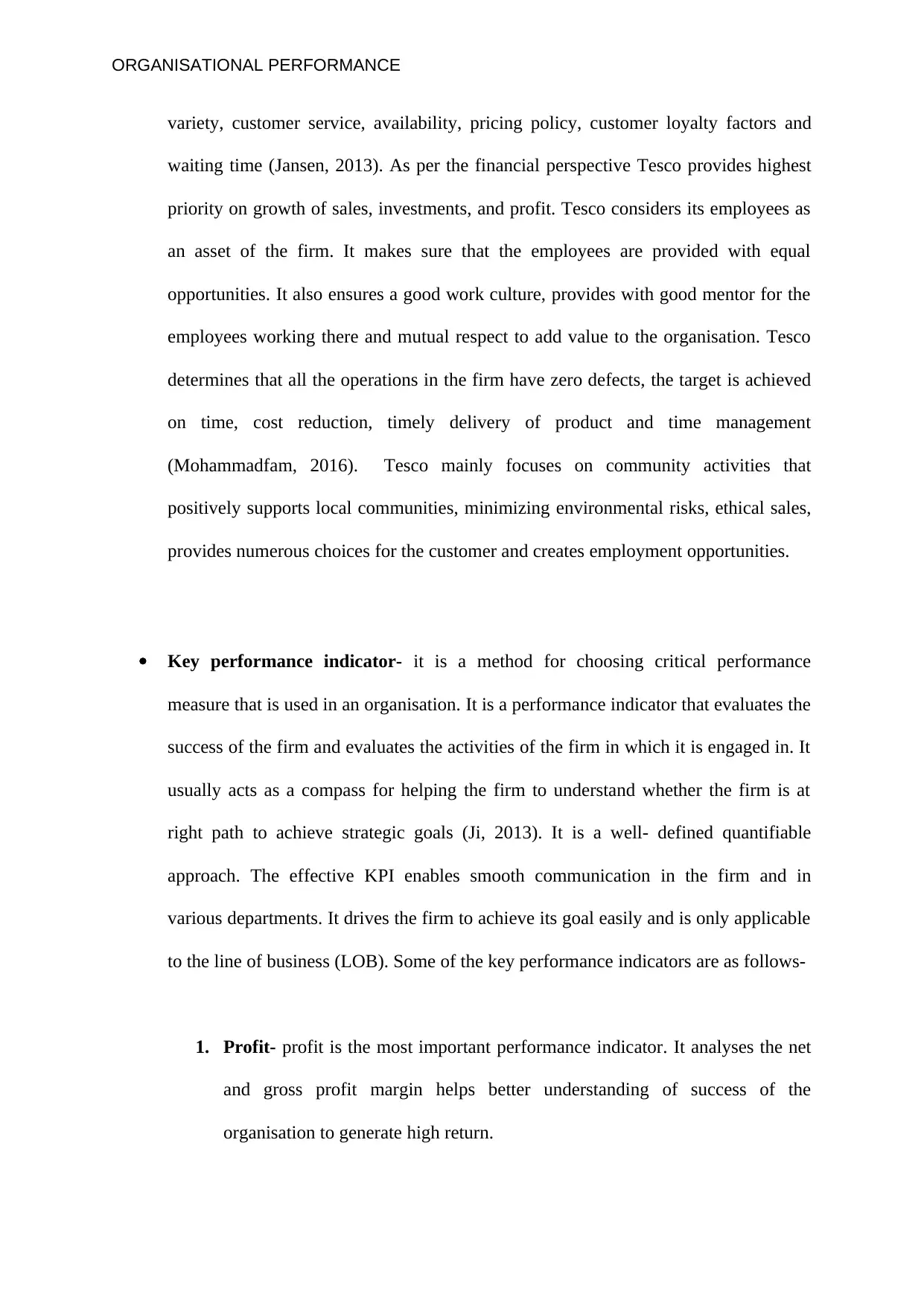
ORGANISATIONAL PERFORMANCE
variety, customer service, availability, pricing policy, customer loyalty factors and
waiting time (Jansen, 2013). As per the financial perspective Tesco provides highest
priority on growth of sales, investments, and profit. Tesco considers its employees as
an asset of the firm. It makes sure that the employees are provided with equal
opportunities. It also ensures a good work culture, provides with good mentor for the
employees working there and mutual respect to add value to the organisation. Tesco
determines that all the operations in the firm have zero defects, the target is achieved
on time, cost reduction, timely delivery of product and time management
(Mohammadfam, 2016). Tesco mainly focuses on community activities that
positively supports local communities, minimizing environmental risks, ethical sales,
provides numerous choices for the customer and creates employment opportunities.
Key performance indicator- it is a method for choosing critical performance
measure that is used in an organisation. It is a performance indicator that evaluates the
success of the firm and evaluates the activities of the firm in which it is engaged in. It
usually acts as a compass for helping the firm to understand whether the firm is at
right path to achieve strategic goals (Ji, 2013). It is a well- defined quantifiable
approach. The effective KPI enables smooth communication in the firm and in
various departments. It drives the firm to achieve its goal easily and is only applicable
to the line of business (LOB). Some of the key performance indicators are as follows-
1. Profit- profit is the most important performance indicator. It analyses the net
and gross profit margin helps better understanding of success of the
organisation to generate high return.
variety, customer service, availability, pricing policy, customer loyalty factors and
waiting time (Jansen, 2013). As per the financial perspective Tesco provides highest
priority on growth of sales, investments, and profit. Tesco considers its employees as
an asset of the firm. It makes sure that the employees are provided with equal
opportunities. It also ensures a good work culture, provides with good mentor for the
employees working there and mutual respect to add value to the organisation. Tesco
determines that all the operations in the firm have zero defects, the target is achieved
on time, cost reduction, timely delivery of product and time management
(Mohammadfam, 2016). Tesco mainly focuses on community activities that
positively supports local communities, minimizing environmental risks, ethical sales,
provides numerous choices for the customer and creates employment opportunities.
Key performance indicator- it is a method for choosing critical performance
measure that is used in an organisation. It is a performance indicator that evaluates the
success of the firm and evaluates the activities of the firm in which it is engaged in. It
usually acts as a compass for helping the firm to understand whether the firm is at
right path to achieve strategic goals (Ji, 2013). It is a well- defined quantifiable
approach. The effective KPI enables smooth communication in the firm and in
various departments. It drives the firm to achieve its goal easily and is only applicable
to the line of business (LOB). Some of the key performance indicators are as follows-
1. Profit- profit is the most important performance indicator. It analyses the net
and gross profit margin helps better understanding of success of the
organisation to generate high return.
⊘ This is a preview!⊘
Do you want full access?
Subscribe today to unlock all pages.

Trusted by 1+ million students worldwide
1 out of 21
Related Documents
Your All-in-One AI-Powered Toolkit for Academic Success.
+13062052269
info@desklib.com
Available 24*7 on WhatsApp / Email
![[object Object]](/_next/static/media/star-bottom.7253800d.svg)
Unlock your academic potential
Copyright © 2020–2025 A2Z Services. All Rights Reserved. Developed and managed by ZUCOL.





